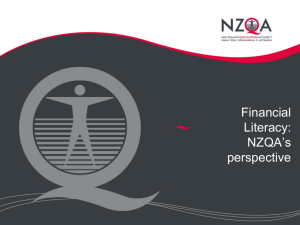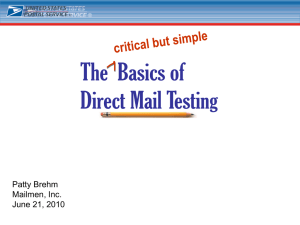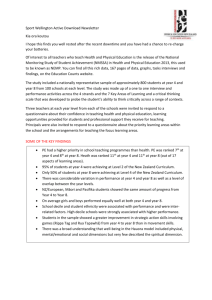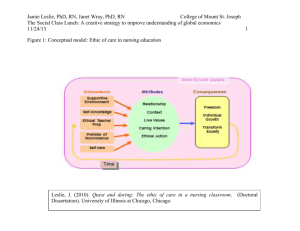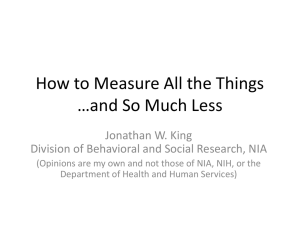D M F S
advertisement
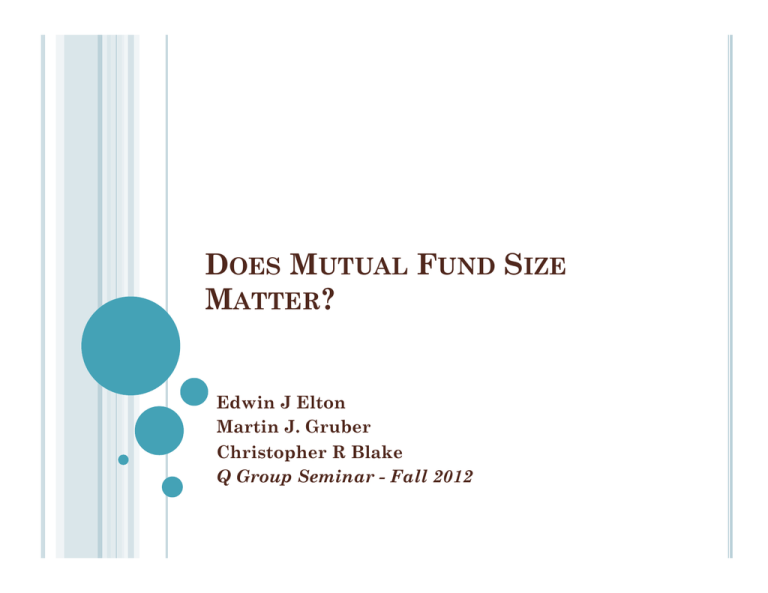
DOES MUTUAL FUND SIZE MATTER? Edwin J Elton Martin J. Gruber Christopher R Blake Q Group Seminar - Fall 2012 Do actively managed mutual funds outperform indexes of the same risk? Do mutual fund managers have information? 1986 1995 270 funds 1999 2009 1,900 funds alpha -0.65 -0.66 Fees 1.25 1.18 Added value before fees 0.60 0.52 2 In earlier studies we found that managers’ past performance is predicative of future performance. 3 CAN THERE BE PREDICTABILITY? Management of mutual funds is not priced. A fund managed by a good manager will sell at net asset value. A fund managed by a bad manager will sell at net asset value. GENERALIZED RULE While the market for securities is almost efficient, the market for managers is not efficient. 4 Berk and Green 2004: there cannot be superior performance or any predictability 1) Managers capture all excess performance in fees 2) Good managers have large amounts of cash flow, their funds under management will grow, and there are diseconomies of scale 1. Higher transaction costs 2. Accepting inferior investments 3. Span of management control 5 Pollett and Wilson: management overwhelmingly reacts to increases by placing new inflows in existing securities. A doubling of size increases the number of stocks held by less than 10% What happens to trading costs and size: Keim & Madhaven (1995) - up Edelen, Evans and Kadlec (2002) – up Christofferson, Keim and Musto (2006) – down Chan, Faff, Gallagher, and Looi (2009) – no impact We observe return after trading costs so to the extent that trading costs go up with size - the effect is incorporated in our data. 6 We agree with Berk and Green that some of their influence may be important. But even if important the time span for their influences to become important is sufficiently long that predictability still exists. Specifically we find size does not destroy predictability over horizons which are sufficiently long to be important. 7 SAMPLE All domestic common stock funds in the CRSP database for the period 1999-2009 No international funds, index funds, sector funds, life cycle funds, flexible funds and funds backing variable annuity products. For total assets all asset classes combined. Returns are for the fund with the longest lived asset class. In each year for predicting the future eliminated funds with: 1. Less than $15 million in assets 2. Existed for less than 3 years 3. Had an R² with the model less than .60 ALL KNOWN AT TIME OF FORECAST Final sample more than 3,000 funds and 17,500 fund years. 8 DISTRIBUTION BY FUND SIZE PANEL A SAMPLE YEAR NUMBER OF FUNDS PANEL B AVERAGE TNA (Millions) TNA Range (Millions) Percentage of Funds in Range (All Years) $15<$50 14.8% $50<$100 13.4% $100 <$250 20.5% $250<$500 14.8% $500<$1,000 13.7% $1,000<$2,000 9.6% $2,000<$4,000 6.0% 1999 1,377 $1,798.2 2000 1,539 $1,565.4 2001 1,680 $1,302.7 2002 1,711 $1,021.4 2003 1,843 $1,302.7 2004 1,890 $1,485.8 2005 1,894 $1,600.5 2006 1,919 $1,795.3 $4,000<$10,000 4.7% 2007 1,940 $1,901.2 $10,000<$20,000 1.4% 2008 1,950 $1,135.9 >=$20,000 1.2% All Years 17,743 $1,488.5 9 QUESTIONS OF INTEREST a) b) c) d) e) f) g) Do funds outperform indexes of same risk Is there predictability in performance Do funds that perform well in the past produce positive future alpha Does size affect performance and predictability of performance What is the relationship between performance and future expense and management fees What variables affect future performance and how important is past performance among this set of variables Some preliminary results from a new study of separate accounts 10 MODELS AND METHODOLOGY All of the models we use for forecasting and evaluation are multi-index models of the form 1. is the return on the fund. 2. is the return on the 30-day Treasury bill rate. 3. is the excess return on an index. It is either the return on a single portfolio minus the return on the 30-day T-bill or the difference in return of two portfolios. 4. are sensitivity coefficients. 5. is the measure of performance. 6. is the random error. 11 MODELS USED 1. 2. 3. 4. Fama French (market, size, growth vs. value) Fama French plus bonds Fama French plus momentum Fama French plus momentum plus bonds Source 1. French website 2. Barclays government - corporate 12 FOR ALL MODELS Computed α in ranking year and formed deciles Examined α in subsequent year for each decile Used weekly data in estimation Example: Ranking year 2000 – estimate α and placed in 10 deciles by α in the ranking year Evaluation year 2001 – computed α for all funds in each decile 13 AVERAGE EVALUATION ALPHAS FUNDS ARE RANKED BY THE FIVE-FACTOR (CARHART PLUS BOND) MODEL Decile Carhart 4-Factor Plus Bond Factor 5Factor Model Evaluation Alpha Decile 1 (lowest) -0.048 Decile 2 -0.027 Decile 3 -0.020 Decile 4 -0.021 Decile 5 -0.016 Decile 6 -0.015 Decile 7 -0.011 Decile 8 -0.003 Decile 9 0.004 Decile 10 (highest) 0.030 Spearman Corr. 0.988 p -value <.0001 14 Note that the top decile has a positive alpha. What is the probability that this could occur by chance Performed simulation Each year divided funds into 10 groups randomly. Computed the alpha for each of the 10 groups. Did this 1000 times. The probability of getting an alpha as high as we found for decile 10 is considerably less than 1%. 15 Not only do we find predictability across deciles the top decile did about 1.5% per year better than index funds 16 EVALUATION ALPHAS WHEN FUNDS ARE RANKED BY SIZE Ranked within objective category by Relative size Carhart Bond Plus model (17,743 fund years) Rank TNA computed relative to category size Evaluation alpha Exp. ratio Turnover Decile 1 0.016 -0.018 1.37 1.032 Decile 2 .035 -0.015 1.29 0.957 Decile 3 .061 -0.013 1.24 0.934 Decile 4 .102 -0.019 1.25 0.989 Decile 5 .161 -0.011 1.25 0.954 Decile 6 .256 -0.019 1.19 0.901 Decile 7 .417 -0.008 1.14 0.858 Decile 8 .701 -0.013 1.10 0.795 Decile 9 1.352 -0.005 1.04 0.755 Decile 10 6.900 -0.007 0.93 0.590 Overall Avg -0.013 Rank Correlation 0.624 P- value 0.054 17 SOME ADDITIONAL METHODOLOGY Dimson & March (non-synchronous trading) Lead and Lag indexes by 1 period sum of 3 betas Christopherson, Ferson and Turner (conditional beta) For each index add a term index times the lagged dividend yield and the lagged short term interest rate (lagged dividend yield) + (lagged short term interest) 18 ADDITIONAL EVALUATION ALPHAS Decile Carhart 4-Factor Plus Bond DM Correction FS Correction 1 -0.048 -0.05 -0.056 2 -0.027 -0.025 -0.027 3 -0.020 -0.017 -0.022 4 -0.021 -0.017 -0.021 5 -0.016 -0.015 -0.017 6 -0.015 -0.014 -0.016 7 -0.011 -0.013 -0.012 8 -0.003 0.004 0.005 9 0.004 0.002 0.000 10 0.030 0.032 0.017 Spearman Corr. .988 .988 1.00 P- value <.0001 19 <.0001 <.0001 MORE EVALUATION ALPHAS Rank Fama French 3-Factor Carhart 4-Factor Model Fama French 3-Factor plus bond factor (4-factor) Decile 1 -0.064 -0.049 -0.061 Decile 2 -0.032 -0.026 -0.032 Decile 3 -0.022 -0.019 -0.024 Decile 4 -0.023 -0.018 -0.026 Decile 5 -0.019 -0.014 -0.021 Decile 6 -0.022 -0.014 -0.022 Decile 7 -0.013 -0.010 -0.014 Decile 8 -0.007 -0.005 -0.005 Decile 9 -0.001 0.000 0.004 Decile 10 +0.026 0.019 0.037 Spearman Correlation 0.976 0.988 0.976 P- value <.0001 <.0001 <.0001 20 EVALUATION ALPHAS WHEN FUNDS ARE RANKED AND EVALUATED BY 5-FACTOR (CARHART PLUS BOND) MODEL (RANKING YEARS 1999-2008) BOTTOM HALF OF TNA TOP HALF OF TNA TNA >= $500 million TNA >= $1 billion TNA >= $8 billion Rank Alpha Alpha Alpha Alpha Alpha Decile 1 -0.054 -0.043 -0.034 -0.029 -0.032 Decile 2 -0.024 -0.026 -0.022 -0.020 -0.022 Decile 3 -0.030 -0.010 -0.012 -0.016 -0.017 Decile 4 -0.024 -0.016 -0.014 -0.013 -0.012 Decile 5 -0.021 -0.019 -0.018 -0.018 0.009 Decile 6 -0.013 -0.016 -0.010 -0.014 -0.002 Decile 7 -0.011 -0.006 -0.008 -0.006 -0.005 Decile 8 -0.010 -0.002 0.003 0.007 -0.008 Decile 9 0.009 0.003 0.001 -0.004 0.009 Decile 10 0.026 0.034 0.030 0.027 0.028 Overall Avg. -0.015 -0.010 -0.008 -0.009 -0.005 Fund Years 8,872 8,872 6,492 4,063 615 Rank Corr. 0.9636 0.9152 0.9394 0.9273 0.8303 p - Value <.0001 0.0002 <.0001 0.0001 0.0029 Avg Size 108 2,867 3,750 5,563 21,780 21 AVERAGE EXPENSE RATIOS AND MANAGEMENT FEES FUND GROUP EXPENSE RATIO MANAGEMENT FEE DIFFERENTIAL Overall 1.18 0.71 0.47 Bottom ½ of TNA 1.28 0.73 0.55 Top ½ of TNA 1.09 0.70 0.39 TNA >= $500 million 1.04 0.67 0.37 TNA >= $1 billion 0.99 0.64 0.35 TNA >= $3 billion 0.90 0.57 0.33 TNA >= $8 billion 0.79 0.49 0.30 22 CHANGE IN EXPENSE RATIOS AND CHANGE IN MANAGEMENT FEES REGRESSED ON CHANGE IN SIZE Variable Total Funds No. Sig Positive No. Sig Negative No. Positive No. Negative CHANGE IN EXPENSE RATIO 953 15 78 259 666 CHANGE IN MANAGEMENT FEE 953 28 32 410 495 CHANGE IN DIFFERENTIAL 953 8 86 263 690 This table shows the number of coefficients that are positive and the number that are negative, along with the number that are statistically significant at the 5% level when changes in expense ratios, changes in managements fees, and changes in those parts of expense ratios net of management fees are regressed on changes in fund size (TNA). Differential is expense ratio minus management fee. Changes and percentage changes are calculated using coincident and 1-year lagged values. ΔE = a + b Δ size 23 AVERAGE CHANGE IN EXPENSE RATIO IN YEARS FOLLOWING RANKING YEAR WHERE FUNDS ARE RANKED BY ALPHA Decile 1 Year 2 Year 3 Year 1 0.0144 0.0155 0.0066 2 0.0070 0.0043 -0.0005 3 0.0054 0.0031 -0.0001 4 0.0018 0.0011 0.0004 5 -0.0004 0.0027 0.0029 6 0.0021 -0.0046 0.0007 7 0.0017 -0.0024 0.0040 8 -0.0043 0.0036 -0.0035 9 -0.0052 -0.0012 -0.0049 10 -0.0217 -0.0059 -0.0057 24 Regression Results 25 The dependant variable we examine is the average weekly evaluation alpha in any year. We explain this alpha using the following set of variables: 1. 2. 3. 4. 5. 6. The average weekly alpha for a fund in the prior year (ranking alpha). The percent cash flow to the fund in the preceding year. Cash flow is defined as the total net assets at the end of a year minus the beginning total net assets times one plus the rate of return on the fund, all divided by the beginning total net assets (TNA). The size of the fund. This is measured as the log of TNA of the fund at the end of the prior year. The expense ratio of the fund in the prior year. The turnover ratio in the prior year. Family size in the prior year. Family size is measured by the aggregate of the TNA of all the funds in a fund family minus the TNA across all share classes of the fund being examined. 26 REGRESSION OUTPUT FROM REGRESSING EVALUATION ALPHAS ON LISTED VARIABLES (OBJECTIVE AND SAMPLE YEAR DUMMY VARIABLES INCLUDED IN REGRESSIONS) Model Obs Adj Rsq Interce pt Rank Alpha Cash Flow Percent In Portno Tna Exp Ratio Turn Ratio Diff Log Size Reg 1 0.168 0.04475 0.1192 -0.00008 -0.00029 -1.56556 -0.01033 0.00068 6.32 16.44 -3.06 -0.44 -6.64 -8.82 1.28 0.04908 0.119 -0.00008 -0.00044 -1.6142 -0.01017 7.88 16.44 -3.11 -0.68 6.64 -8.73 0.01874 -0.00348 -0.00058 -0.00809 -0.00896 T VALUE Reg 2 T VALUE Effects of a 1-StandardDeviation Change for Regression 2 0.168 27 REGRESSION OUTPUT FROM REGRESSING EVALUATION ALPHAS ON LISTED VARIABLES (OBJECTIVE AND SAMPLE YEAR DUMMY VARIABLES INCLUDED IN REGRESSIONS) Dependent Variable Is First Year Evaluation Alpha Adj. RSquare Intercept Ranking Alpha Cash Flow % Log TNA Expense Ratio Turnover Ratio Family Size Differential 0.2145 0.02257 (3.00) 0.1802 (23.53) -0.00011 (-3.95) -0.00081 (-1.15) -1.5654 (-6.18) -0.0092 (-7.58) 0.00039 (0.67) Dependent Variable Is Average of First and Second Year Evaluation Alphas Adj. RSquare Intercept Ranking Alpha Cash Flow % Log TNA Expense Ratio Turnover Ratio Family Size Differential 0.14566 0.00183 (0.34) 0.0753 (13.67) -0.00009 (-4.46) -0.00092 (-1.82) -1.8159 (-9.96) -0.0113 (-12.96) 0.00085 (2.05) Dependent Variable Is Average of First, Second and Third Year Evaluation Alphas Adj. RSquare Intercept Ranking Alpha Cash Flow % Log TNA Expense Ratio Turnover Ratio Family Size Differential 0.12108 0.01228 (2.83) 0.0279 (6.32) -0.00008 (-4.82) -0.0003 (-0.75) -1.7974 (-12.31) -0.0099 (-14.19) 0.00125 (3.76) 28 1. 2. 3. 4. 5. 6. 7. First and foremost, the regressions are statistically significant and they all show forecasting ability. The coefficient of determination goes down from 0.21 to 0.15 to 0.12. The importance of past alphas in explaining future alphas decreases. However, even for the case of a three-year forecast, past alpha is still statistically significant at the 0.01 level an a one standard deviation change in past alpha has an impact on the three-year alpha of 23 basis points per year. The importance of both expense ratio and turnover ratio increases as we forecast for longer horizons. The t value of each of these variables increases, as does the impact of a one-standard deviation change in each of these variables. The impact of cash flows does not change in importance, and remains statistically significant. Portfolio size is not significant in any case. The importance of family size increases with longer horizons. It is not significant in the one-year case, but becomes statistically significant for the two-and three-year case. 29 CONCLUSIONS: There is a strong relationship between past and future alphas The best performing funds produce positive future alphas Growth in fund size erodes predictability, but slowly Size is not as important as past speculation would suggest Why doesn't performance and predictability disappear for large funds -a) we know expense ratios go down with size b) while size and particularly fund flow due to success lead to either larger trades or more investments, large funds may gain better analysts (they can pay more) or command the best resources of the fund family to which they belong 30 Separate Accounts 31 SAMPLE All separate accounts listed on Morningstar Direct 32 33 34 REASONS FOR DIFFERENCE 1. 2. 3. Note that any benchmark can be explained in part by multi-index model When separate accounts are regressed on an index relative sensitivity to each factor is fixed and equal to the beta on the benchmark times beta on the factor Thus differences in alphas are determined by differences in the sensitivity to the factors using the multi-index and the implicit sensitivity using the manager designated index 35 WHAT WERE PRINCIPAL DIFFERENCES 1. 2. 3. 4. Greater market sensitivity than indicated by manager’s benchmark Tilted smaller than indicated by manager’s benchmark Funds designated as growth had more value tilt than indicated by manager’s benchmark Momentum is zero for any index but manager designated growth accounts had positive loading 36
